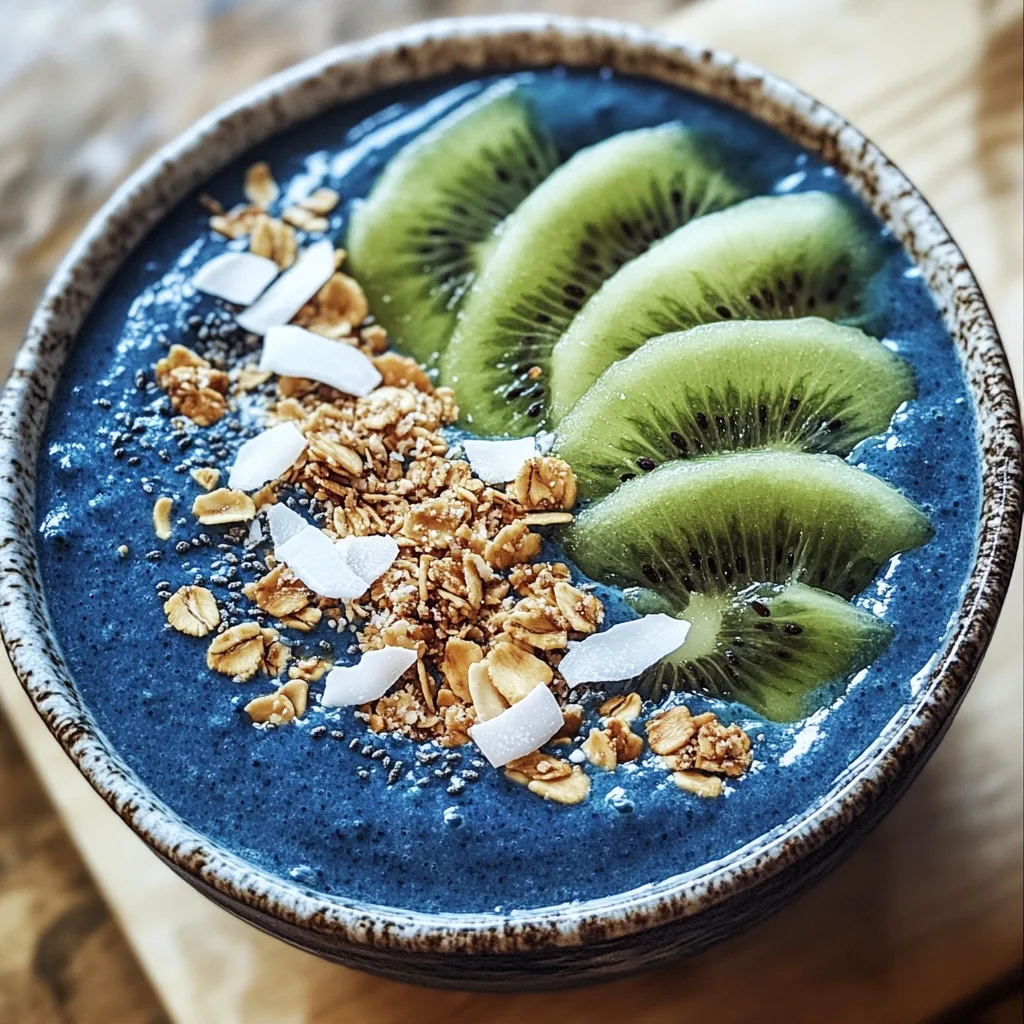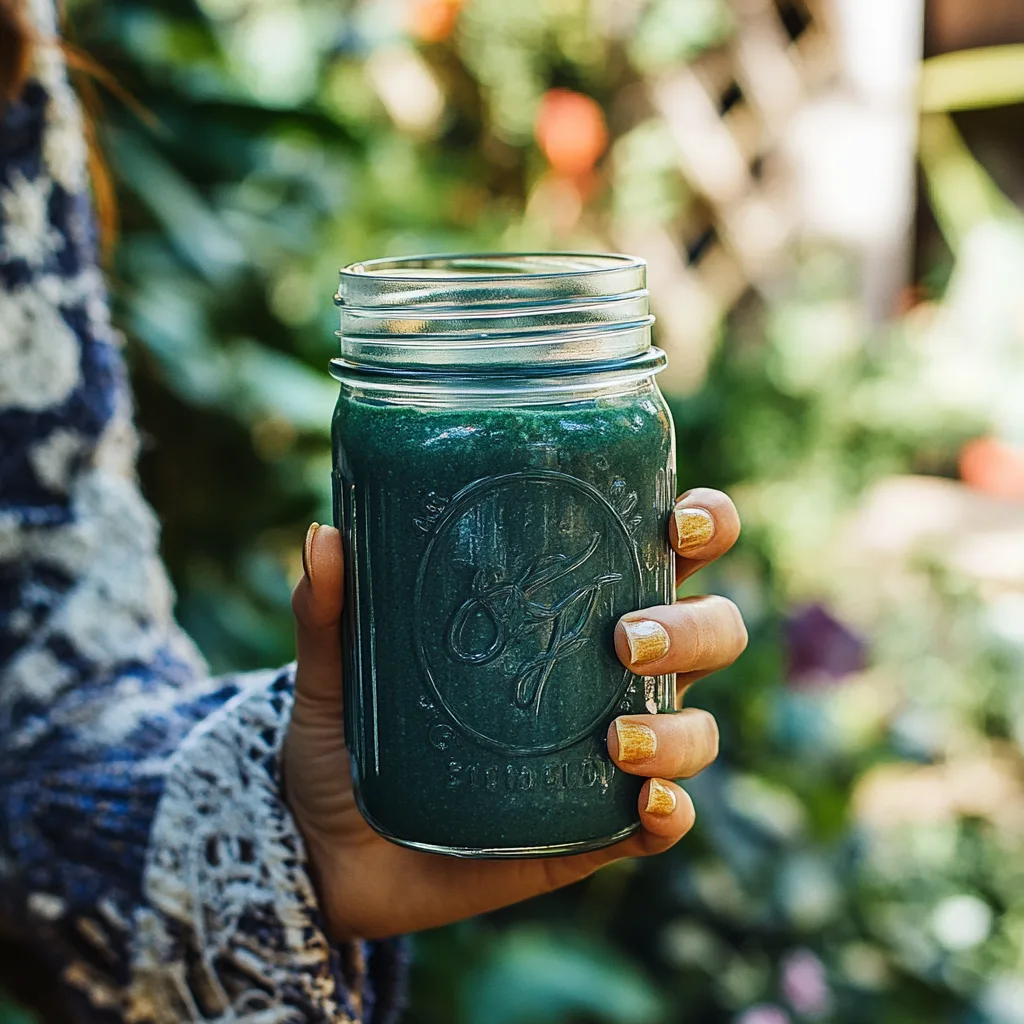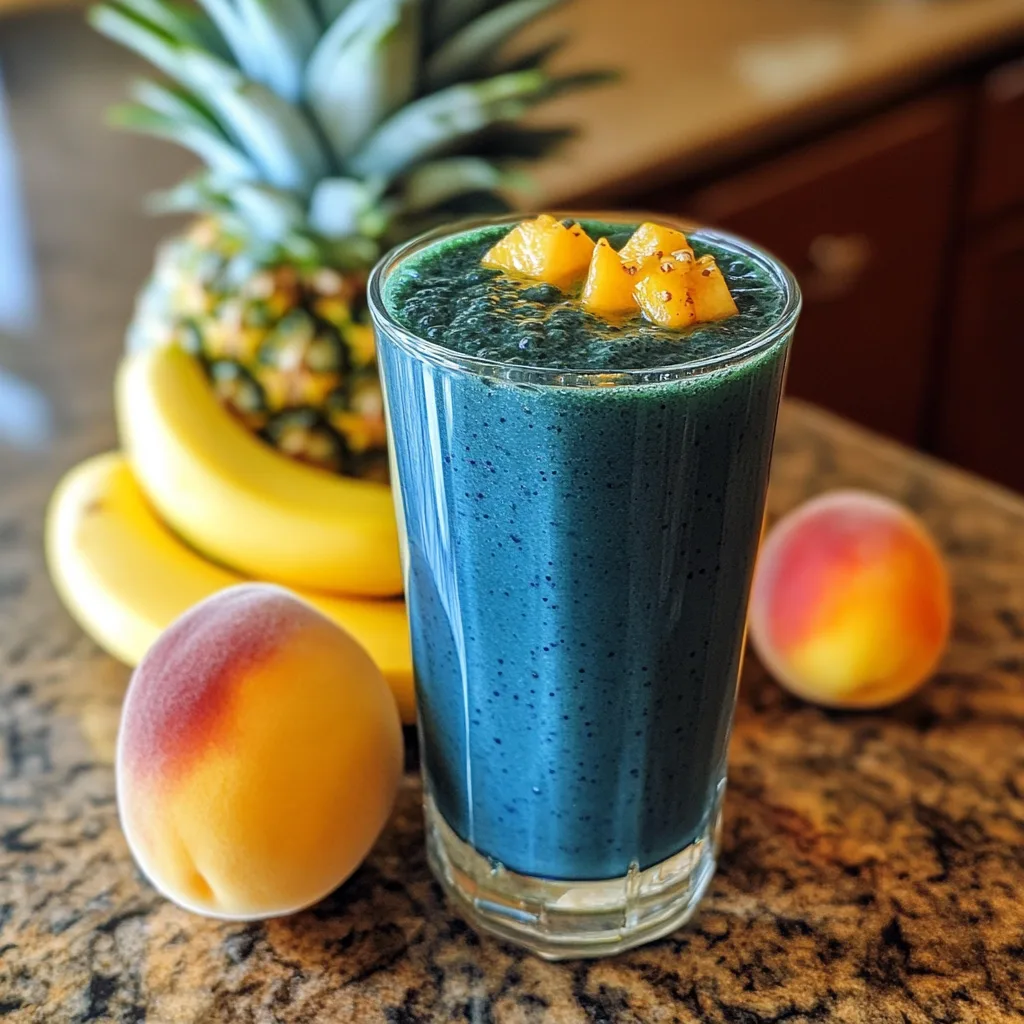Smoothies are a go-to breakfast for many, and now they’re brighter, bolder, and better than ever thanks to the blue spirulina smoothie. This eye-catching drink has made its way from health food cafes to Instagram feeds, and for good reason. Its vibrant color and impressive nutrition profile make it a must-try for wellness lovers.
In this post, we’ll explore what makes the blue spirulina smoothie so special from its health perks and subtle taste to how it stacks up against green spirulina. Plus, we’ll show you how to whip up your own vibrant, nutrient-packed smoothie using just a few easy ingredients.
Want more hydrating wellness ideas? Explore our Loaded Water Recipes to stay refreshed all day long.
What Is Blue Spirulina and Why Is It Trending?
Blue spirulina technically called phycocyanin is a pigment-rich extract from green spirulina algae. While green spirulina includes the full algae and tends to have a strong oceanic flavor, blue spirulina is refined to highlight its striking color and potent antioxidant content.
What makes the blue spirulina smoothie especially appealing is that the powder itself is nearly tasteless. This allows it to blend beautifully with fruits, nut milks, or yogurts enhancing the nutrition without changing the flavor.
Its key claim to fame? A high concentration of antioxidants that help fight inflammation, support immune strength, and reduce oxidative stress all wrapped in a visually stunning blue hue.
What’s Inside a Blue Spirulina Smoothie?
Here’s why just a teaspoon of this superfood powder can transform your smoothie into a health-boosting powerhouse:
| Nutrient | Amount per tsp |
|---|---|
| Protein | 2g |
| Antioxidants | High (phycocyanin-rich) |
| B Vitamins | B1, B2, B3 |
| Iron | Up to 11% of Daily Value |
| Beta-carotene | Present |
Adding blue spirulina to your daily smoothie isn’t just about looks it’s about function. This natural pigment delivers impressive health benefits while being sugar-free, gluten-free, and entirely vegan-friendly.
Whether you’re upgrading your breakfast or looking to boost your immune system, the blue spirulina smoothie offers both style and substance.
Discover great ideas like Pink Salt Weight Loss Recipe for more superfood-packed options.
PART 2: Health Benefits of Blue Spirulina in Smoothies
Immune-boosting antioxidants and essential nutrients
One of the main reasons people add blue spirulina to their smoothies is its incredible antioxidant power. Rich in phycocyanin, blue spirulina helps the body neutralize free radicals those unstable molecules that can damage cells and weaken your immune defenses.
It also contains essential vitamins and minerals like B vitamins, iron, and beta-carotene, which are known to support everything from energy production to skin health. Regularly enjoying a blue spirulina smoothie may help reduce inflammation, promote better immunity, and even contribute to clearer skin and improved mood.
For those following plant-based or dairy-free diets, blue spirulina is also an easy way to sneak in added nutrients without any synthetic supplements.
Energy, inflammation, and detoxification support
Looking for a natural energy booster? Blue spirulina is packed with plant-based protein and essential amino acids that may help support stamina and reduce fatigue making it perfect for a morning or post-workout smoothie.
Its anti-inflammatory properties are another big win. Inflammation is a root cause of many chronic conditions, and the antioxidants in blue spirulina may help calm the body and support recovery after exercise.
Many wellness seekers also embrace spirulina for its natural detoxifying properties. It’s believed to help the body flush out toxins and support liver function especially when combined with hydrating fruits like pineapple or peaches.
This makes your blue spirulina smoothie not just a pretty Instagram photo but a powerful wellness drink.
Don’t miss our Pink Salt Weight Loss Recipe for another anti-inflammatory health boost.
PART 3: Taste and Texture – Can You Taste Blue Spirulina in Smoothies?
Is blue spirulina flavor noticeable in smoothies?
One of the most common questions people have is: “Can you actually taste a blue spirulina smoothie?” The simple truth? Blue spirulina smoothie blends are known for being nearly flavorless. Unlike the stronger, earthier taste of green spirulina, blue spirulina is extracted to preserve nutrients while eliminating the algae-like flavor. That makes a blue spirulina smoothie the perfect canvas for tropical fruit, creamy bases, and even citrus.
Whether you’re mixing it with banana, pineapple, or oat milk, your blue spirulina smoothie will taste just as fruity and refreshing as you’d expect without any trace of seaweed.
In other words, your smoothie still tastes like fruit not the ocean.
Ways to mask or enhance its subtle taste
Even though blue spirulina doesn’t have a strong taste, how you pair it with other ingredients matters. If you’re sensitive to even the mildest aftertaste, here are a few quick tips to enhance your smoothie’s flavor:
- Use tropical fruits like pineapple and mango to naturally sweeten and overpower any hint of algae.
- Add creamy elements such as banana or oat milk to soften texture and balance flavors.
- A small splash of vanilla extract or a spoonful of nut butter can add depth and richness.
- Use citrus juices like orange or lime to brighten and enhance flavor contrast.
These simple hacks make it even easier to fall in love with your blue spirulina smoothie, turning it into both a health drink and a flavor-packed experience.
Check out Loaded Water Recipes for more refreshing, clean-flavored options.
PART 4: How to Make a Delicious Blue Spirulina Smoothie

Ingredients and blending techniques
Making a blue spirulina smoothie at home is incredibly easy and takes just a few minutes. With the right combination of frozen fruit and plant-based milk, you’ll have a colorful, nutrient-rich drink that tastes as good as it looks.
Try this easy and refreshing recipe to kick things off:
Blue Spirulina Smoothie Recipe
| Ingredient | Amount |
|---|---|
| Frozen pineapple chunks | 1 cup |
| Frozen peach slices | 1 cup |
| Fresh banana | ½ ripe banana |
| Blue spirulina powder | 1 teaspoon |
| Oat milk (or any plant-based milk) | 1 cup |
Instructions:
- Add all the ingredients into a high-speed blender.
- Blend until completely smooth and creamy.
- Pour into a glass, jar, or smoothie bowl.
- Serve immediately and enjoy!
This combination delivers the perfect balance of creaminess, sweetness, and superfood power all in one blue spirulina smoothie. The pineapple and peach add natural sugars and vitamin C, while the banana provides texture and potassium. Blue spirulina sneaks in antioxidants without altering the taste, and oat milk ties it all together with a creamy finish.
Best fruits, liquids, and superfood pairings
Want to mix it up? Here are some excellent add-ins and swaps to personalize your blue spirulina smoothie:
- Fruit swaps: Mango, blueberries, or strawberries
- Liquid alternatives: Almond milk, coconut water, or cashew milk
- Add-ins: Chia seeds, hemp hearts, or flaxseed
- Flavor enhancers: A splash of lime juice, vanilla extract, or a medjool date for sweetness
Adding a handful of greens like baby spinach can increase the fiber content without impacting flavor too much. And for a thicker smoothie bowl consistency, reduce the amount of liquid and add a few ice cubes or more frozen fruit.
Whether you’re enjoying it as a quick breakfast, a pre-workout boost, or a midday treat, this customizable blue spirulina smoothie is a vibrant and health-conscious choice.
PART 5: Blue vs. Green Spirulina – Which One is Better?
Key differences in nutrition and appearance
Blue and green spirulina originate from the same algae family, but they differ in processing methods and nutritional benefits. Here’s a quick breakdown:
| Feature | Blue Spirulina | Green Spirulina |
|---|---|---|
| Source | Extracted from green spirulina | Whole spirulina algae |
| Appearance | Bright electric blue | Deep green |
| Taste | Virtually tasteless | Strong, earthy, ocean-like flavor |
| Nutrient Focus | High in antioxidants (phycocyanin) | Complete protein, vitamins, minerals |
| Best For | Smoothies, bowls, food coloring | Protein powders, supplements |
Blue spirulina smoothie lovers appreciate the clean flavor and vibrant color, making it ideal for recipes where taste matters. It’s also more visually appealing, which explains why it’s often used in smoothie bowls, lattes, and wellness shots.
Green spirulina, on the other hand, is more of a full-spectrum supplement. It contains the entire algae with all its natural nutrients including protein, iron, magnesium, and chlorophyll but comes with a bold taste that not everyone enjoys.
Which spirulina is right for your health goals?
If you’re looking for:
- A tasteless, antioxidant-rich superfood to enhance your smoothies without affecting flavor, blue spirulina is your best choice.
- A complete protein and broader range of nutrients (but don’t mind a strong taste), green spirulina may be more beneficial.
In the end, it all comes down to your individual wellness goals. Many people start with blue spirulina smoothies because they’re easy to enjoy and integrate into everyday routines. It’s an excellent option for kids, picky eaters, or anyone new to superfoods.
For fitness enthusiasts or those with iron deficiencies, green spirulina could be a better fit especially in capsule or tablet form.
PART 6: Creative Blue Spirulina Smoothie Recipes to Try

Adding blue spirulina to your smoothie opens the door to a whole new level of color, creativity, and clean nutrition. Below are two unique blue spirulina smoothie recipes you can try at home designed to please your taste buds and brighten your day.
Tropical Blue Sunrise Smoothie
This vibrant drink is perfect for mornings when you want something bright, fruity, and energizing. Featuring tropical fruits like pineapple and mango, this blend delivers a boost of vitamin C, hydration, and antioxidant power.
Ingredients:
- 1 cup frozen pineapple chunks
- 1 cup frozen mango
- ½ banana
- 1 teaspoon blue spirulina powder
- ¾ cup coconut water
- Juice of half a lime
Instructions:
- Combine all ingredients in a high-powered blender.
- Process the mixture until it turns velvety smooth with no chunks remaining.
- Pour into a tall glass and top with fresh mint or a pineapple wedge for a vibrant, eye-catching finish.
Why You’ll Love It: The sweet fruit masks any subtle spirulina notes while the lime brightens the flavor, creating a tropical escape in every sip.
Creamy Coconut Blue Bowl
This creamy, spoonable smoothie bowl is packed with plant-based nutrients and nourishing healthy fats. Perfect for a hearty breakfast or to refuel after a workout.
Ingredients:
- 1 frozen banana
- ½ cup frozen peach slices
- ½ cup full-fat coconut milk
- 1 teaspoon blue spirulina powder
- 1 tablespoon chia seeds
Toppings Ideas:
- Fresh kiwi slices
- Coconut flakes
- Blueberries
- Granola, flaxseed, or hemp hearts
Instructions:
- Blend everything together until smooth and luxuriously thick.
- Transfer the smoothie to a bowl and top it with your favorite fruits and crunch.
- Dig in with a spoon and enjoy slowly for a more satisfying experience.
Why You’ll Love It: It’s nutrient-dense, filling, and visually stunning perfect for both your body and your Instagram feed.
PART 7: When and How Often to Drink Spirulina Smoothies

Best times to consume for maximum benefits
To get the most out of your blue spirulina smoothie, timing matters. While you can enjoy it any time of the day, there are specific windows where its nutrients are absorbed more effectively:
- Morning boost: Drinking a blue spirulina smoothie first thing in the morning is ideal. It kick-starts your metabolism, provides clean energy, and floods your system with antioxidants and vitamins before your day begins.
- Post-workout recovery: Packed with plant-based protein and anti-inflammatory nutrients, spirulina is an excellent choice for replenishing after exercise. Blending it with fruits and a plant-based milk like oat or almond can help replenish electrolytes and reduce muscle soreness.
- Mid-afternoon pick-me-up: Instead of reaching for a sugary snack or a second cup of coffee, a smoothie with blue spirulina offers a steady energy lift without the crash.
In all cases, pairing spirulina with natural sugars (from fruits) and a good source of fat (like coconut milk or chia seeds) improves nutrient absorption.
How much blue spirulina is safe per day?
Moderation is key when adding any supplement even natural ones into your diet. For most adults, ½ to 1 teaspoon of blue spirulina powder daily is both safe and effective.
| Age Group | Recommended Dosage |
|---|---|
| Adults | ½ to 1 tsp per day |
| Teens (13–18) | ¼ to ½ tsp per day |
| Children (under 12) | Consult a pediatrician |
It’s always wise to start with a small amount and see how your body responds before increasing the dosage.
If you’re pregnant, breastfeeding, taking medication, or managing a health condition, talk to your doctor before adding spirulina to your routine.
While spirulina is incredibly nutrient-dense, it’s not a replacement for a balanced diet. Think of your blue spirulina smoothie as a daily wellness upgrade not a magic bullet.
PART 8: Potential Side Effects and Considerations
Who should avoid blue spirulina?
While a blue spirulina smoothie is generally safe for most healthy adults, there are certain individuals who should be cautious:
- Pregnant or breastfeeding women: Although spirulina is natural, it’s best to consult your healthcare provider before using it during pregnancy or while nursing.
- People with autoimmune disorders: Spirulina stimulates the immune system. For those with autoimmune diseases like lupus or rheumatoid arthritis, this could potentially worsen symptoms.
- Allergy-prone individuals: Though rare, some people may have an allergic reaction to spirulina, especially if they have sensitivities to algae or iodine.
- Individuals on medications: If you’re taking blood thinners, immunosuppressants, or thyroid medications, talk to your doctor before consuming spirulina regularly.
Safe dosage and sourcing tips
Not all spirulina is created equal. Because spirulina is cultivated in water, it can absorb contaminants if not grown and harvested under clean, controlled conditions. That’s why sourcing matters.
How to choose high-quality blue spirulina:
- Look for organic certifications and lab-tested purity
- Avoid products with fillers, additives, or artificial dyes
- Choose brands that clearly state the country of origin and farming practices
- Opt for phycocyanin-rich spirulina labeled as “blue spirulina” (not just general algae powder)
Always stick to the recommended daily amount of ½ to 1 teaspoon to avoid unnecessary side effects like minor digestive upset or discoloration of stool. These effects are rare and usually harmless but can occur if consumed in excessive amounts.
Your blue spirulina smoothie is a powerful health drink—but like any supplement, it should be used wisely and in balance with your overall nutrition plan.
For more recipes follow me in Facebook.
FAQs
Can you taste blue spirulina in smoothies?
Not really. Blue spirulina has a very mild, almost undetectable taste—especially when blended with fruits like pineapple, banana, or mango. Unlike green spirulina, which can have a strong earthy or seaweed-like flavor, blue spirulina is extracted specifically for its pigment and antioxidant content, leaving most of the taste behind. This makes a blue spirulina smoothie ideal for those who want the health benefits without the funky flavor.
How to make spirulina smoothie?
Making a blue spirulina smoothie is super easy. Just add a teaspoon of blue spirulina powder to your favorite smoothie base—usually a mix of frozen fruits, a banana, and a splash of plant-based milk like oat, almond, or coconut. Blend everything together until smooth. You can enjoy it in a glass or spoon it into a bowl with toppings for a smoothie bowl experience.
Here’s a quick recipe:
1 cup frozen pineapple
1 cup frozen peach
½ banana
1 tsp blue spirulina powder
1 cup oat milk
Blend until smooth and serve fresh!
Is blue spirulina healthier than green?
Both types of spirulina are incredibly nutritious, but they serve different purposes. Green spirulina is made from the whole algae and is rich in protein, iron, chlorophyll, and essential minerals. Blue spirulina is an extract that’s high in phycocyanin, a powerful antioxidant that supports immune function and reduces inflammation.
If taste is important or you’re new to spirulina, blue spirulina is the better choice for smoothies due to its neutral flavor. For those seeking maximum nutrition, green spirulina is more comprehensive.
Is spirulina good for you in smoothies?
Absolutely! Adding spirulina to your smoothie gives you a quick hit of plant-based nutrients, antioxidants, and protein. It helps fight oxidative stress, supports energy levels, and can even boost your immune system. Just make sure you use a quality product and stick to recommended doses. A well-made blue spirulina smoothie is one of the easiest ways to upgrade your health game naturally.
Conclusion: Start Your Day Bright with a Blue Spirulina Smoothie
Whether you’re chasing health goals or just want to add some color to your morning routine, the blue spirulina smoothie is a standout option. It’s nutrient-dense, flavor-neutral, and visually stunning—making it an easy upgrade to any wellness lifestyle.
From boosting immunity and energy to delivering powerful antioxidants without the overpowering taste of traditional greens, blue spirulina is the superfood that fits seamlessly into your routine. With endless recipe variations and health benefits, there’s no better time to make this vibrant smoothie your new favorite.
Looking for more inspiration? Try these:
Find smart ideas in Everyday Wellness Sips (orphan link placeholder)
Discover great ideas like Pink Salt Weight Loss Recipe
Check out Loaded Water Recipes
Explore more health drinks in our Detox section
Don’t miss our guide to Natural Hydration Smoothies (orphan link placeholder)


